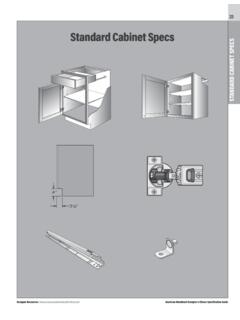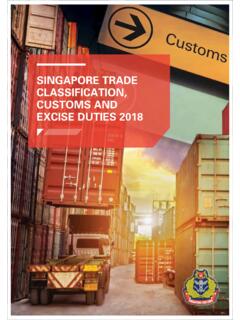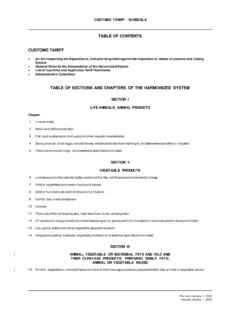Transcription of 11.13 Glass Fiber Manufacturing - US EPA
1 Glass Fiber General1-4 Glass Fiber Manufacturing is the high-temperature conversion of various raw materials(predominantly borosilicates) into a homogeneous melt, followed by the fabrication of this melt intoglass fibers. The 2 basic types of Glass Fiber products, textile and wool , are manufactured by similarprocesses. A typical diagram of these processes is shown in Figure Glass Fiber productioncan be segmented into 3 phases: raw materials handling, Glass melting and refining, and wool glassfiber forming and finishing, this last phase being slightly different for textile and wool Glass Materials Handling -The primary component of Glass Fiber is sand, but it also includes varying quantities offeldspar, sodium sulfate, anhydrous borax, boric acid, and many other materials. The bulk supplies arereceived by rail car and truck, and the lesser-volume supplies are received in drums and raw materials are unloaded by a variety of methods, including drag shovels, vacuum systems,and vibrator/gravity systems.
2 Conveying to and from storage piles and silos is accomplished by belts,screws, and bucket elevators. From storage, the materials are weighed according to the desiredproduct recipe and then blended well before their introduction into the melting unit. The weighing,mixing, and charging operations may be conducted in either batch or continuous Melting And Refining -In the Glass melting furnace, the raw materials are heated to temperatures ranging from1500 to 1700 C (2700 to 3100 F) and are transformed through a sequence of chemical reactions tomolten Glass . Although there are many furnace designs, furnaces are generally large, shallow, andwell-insulated vessels that are heated from above. In operation, raw materials are introducedcontinuously on top of a bed of molten Glass , where they slowly mix and dissolve. Mixing is effectedby natural convection, gases rising from chemical reactions, and, in some operations, by air injectioninto the bottom of the melting furnaces can be categorized by their fuel source and method of heat applicationinto 4 types: recuperative, regenerative, unit, and electric melter.
3 The recuperative, regenerative, andunit melter furnaces can be fueled by either gas or oil. The current trend is from gas-fired to furnaces use a steel heat exchanger, recovering heat from the exhaust gases by exchangewith the combustion air. Regenerative furnaces use a lattice of brickwork to recover waste heat fromexhaust gases. In the initial mode of operation, hot exhaust gases are routed through a chambercontaining a brickwork lattice, while combustion air is heated by passage through anothercorresponding brickwork lattice. About every 20 minutes, the airflow is reversed, so that thecombustion air is always being passed through hot brickwork previously heated by exhaust furnaces melt Glass by passing an electric current through the melt. Electric furnaces areeither hot-top or cold-top. The former use gas for auxiliary heating, and the latter use only the electriccurrent. Electric furnaces are currently used only for wool Glass Fiber production because of theelectrical properties of the Glass formulation.
4 Unit melters are used only for the "indirect" marblemelting process, getting raw materials from a continuous screw at the back of the furnace adjacent tothe exhaust air discharge. There are no provisions for heat recovery with unit (Reformatted 1/95)Mineral Products Typical flow diagram of the Glass Fiber production FACTORS(Reformatted 1/95)9/85In the "indirect" melting process, molten Glass passes to a forehearth, where it is drawn off,sheared into globs, and formed into marbles by roll-forming. The marbles are then stress-relieved inannealing ovens, cooled, and conveyed to storage or to other plants for later use. In the "direct" glassfiber process, molten Glass passes from the furnace into a refining unit, where bubbles and particles areremoved by settling, and the melt is allowed to cool to the proper viscosity for the Fiber Glass Fiber Forming And Finishing - wool fiberglass is produced for insulation and is formed into mats that are cut into batts.(Loose wool is primarily a waste product formed from mat trimming, although some is a primaryproduct, and is only a small part of the total wool fiberglass produced.)
5 No specific emission data forloose wool production are available.) The insulation is used primarily in the construction industry andis produced to comply with ASTM C167-64, the "Standard Test Method for Thickness and Density ofBlanket- or Batt-Type Thermal Insulating Material". wool fiberglass insulation production lines usually consist of the following processes:(1) preparation of molten Glass , (2) formation of fibers into a wool fiberglass mat, (3) curing thebinder-coated fiberglass mat, (4) cooling the mat, and (5) backing, cutting, and packaging theinsulation. Fiberglass plants contain various sizes, types, and numbers of production lines, although atypical plant has 3 lines. Backing (gluing a flat flexible material, usually paper, to the mat), cutting,and packaging operations are not significant sources of emissions to the trimmed edge waste from the mat and the fibrous dust generated during the cutting andpackaging operations are collected by a cyclone and either are transported to a hammer mill to bechopped into blown wool (loose insulation) and bulk packaged or are recycled to the forming sectionand blended with newly formed the formation of fibers into a wool fiberglass mat (the process known as "forming" inthe industry), Glass fibers are made from molten Glass , and a chemical binder is simultaneouslysprayed on the fibers as they are created.
6 The binder is a thermosetting resin that holds the glassfibers together. Although the binder composition varies with product type, typically the binderconsists of a solution of phenol-formaldehyde resin, water, urea, lignin, silane, and agents may also be added to the binder. Two methods of creating fibers are used by theindustry. In the rotary spin process, depicted in Figure , centrifugal force causes molten glassto flow through small holes in the wall of a rapidly rotating cylinder to create fibers that are brokeninto pieces by an air stream. This is the newer of the 2 processes and dominates the industry the flame attenuation process, molten Glass flows by gravity from a furnace through numerous smallorifices to create threads that are then attenuated (stretched to the point of breaking) by high velocity,hot air, and/or a flame. After the Glass fibers are created (by either process) and sprayed with thebinder solution, they are collected by gravity on a conveyor belt in the form of a conveyor carries the newly formed mat through a large oven to cure the thermosettingbinder and then through a cooling section where ambient air is drawn down through the presents a schematic drawing of the curing and cooling sections.
7 The cooled matremains on the conveyor for trimming of the uneven edges. Then, if product specifications require it,a backing is applied with an adhesive to form a vapor barrier. The mat is then cut into batts of thedesired dimensions and Glass Fiber Forming And Finishing -Molten Glass from either the direct melting furnace or the indirect marble melting furnace istemperature-regulated to a precise viscosity and delivered to forming stations. At the forming9/85(Reformatted 1/95)Mineral Products A typical spin FACTORS(Reformatted 1/95)9/85 Figure Side view of curing oven (indirect heating) and cooling (Reformatted 1/95)Mineral Products , the molten Glass is forced through heated platinum bushings containing numerous very smallopenings. The continuous fibers emerging from the openings are drawn over a roller applicator, whichapplies a coating of a water-soluble sizing and/or coupling agent. The coated fibers are gathered andwound into a spindle. The spindles of Glass fibers are next conveyed to a drying oven, wheremoisture is removed from the sizing and coupling agents.
8 The spindles are then sent to an oven tocure the coatings. The final fabrication includes twisting, chopping, weaving, and packaging the Emissions And Controls1,3,4 Emissions and controls for Glass Fiber Manufacturing can be categorized by the 3 productionphases with which they are associated. Emission factors for the Glass Fiber Manufacturing industry aregiven in Tables , , and Materials Handling -The major emissions from the raw materials handling phase are fugitive dust and raw materialparticles generated at each of the material transfer points. Such a point would be where sand poursfrom a conveyor belt into a storage silo. The 2 major control techniques are wet or moist handlingand fabric filters. When fabric filters are used, the transfer points are enclosed, and air from thetransfer area is continuously circulated through the fabric Melting And Refining -The emissions from Glass melting and refining include volatile organic compounds from themelt, raw material particles entrained in the furnace flue gas, and, if furnaces are heated with fossilfuels, combustion products.
9 The variation in emission rates among furnaces is attributable to varyingoperating temperatures, raw material compositions, fuels, and flue gas flow rates. Of the various typesof furnaces used, electric furnaces generally have the lowest emission rates, because of the lack ofcombustion products and of the lower temperature of the melt surface caused by bottom control for furnaces is primarily fabric filtration. Fabric filters are effective on particulatematter (PM) and sulfur oxides (SOx) and, to a lesser extent, on carbon monoxide (CO), nitrogenoxides (NOx), and fluorides. The efficiency of these compounds is attributable to both condensationon filterable PM and chemical reaction with PM trapped on the filters. Reported fabric filterefficiencies on regenerative and recuperative wool furnaces are for PM, 95+ percent; SOx, 99+ percent;CO, 30 percent; and fluoride, 91 to 99 percent. Efficiencies on other furnaces are lower because oflower emission loading and pollutant Fiber Forming And Finishing -Emissions generated during the manufacture of wool fiberglass insulation include solidparticles of Glass and binder resin, droplets of binder, and components of the binder that havevaporized.
10 Glass particles may be entrained in the exhaust gas stream during forming, curing, orcooling operations. Test data show that approximately 99 percent of the total emissions from theproduction line are emitted from the forming and curing sections. Even though cooling emissions arenegligible at some plants, cooling emissions at others may include fugitives from the curing commingling of emissions occurs because fugitive emissions from the open terminal end of thecuring oven may be induced into the cooling exhaust ductwork and be discharged into the particles of resin may be entrained in the gas stream in either the curing or cooling of organic binder may be entrained in the gas stream in the forming section or may be aresult of condensation of gaseous pollutants as the gas stream is cooled. Some of the liquid binderused in the forming section is vaporized by the elevated temperatures in the forming and curingprocesses. Much of the vaporized material will condense when the gas stream cools in the ductworkor in the emission control FACTORS(Reformatted 1/95)9/85 Table (Metric Units).

















